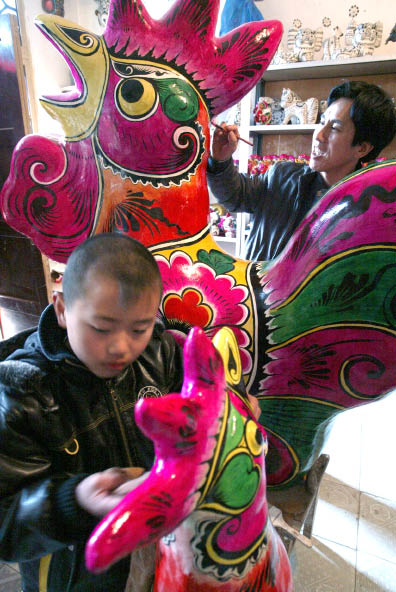|
Clay Figurines in China (I)
By staff reporter XING WEN
CHINESE folklore has it that humans were originally created out of clay by the Goddess Nüwa. Still using her simple materials, Chinese folk artists revive this legend daily by molding delicate clay figurines.
Numbers of clay animal sculptures are unearthed in China regularly and they reveal that the history of making of clay figurines probably dates back to the Neolithic Period. However, it was not until the Ming Dynasty (1368-1644) that clay figurines came into their heyday and became one of the most popular art forms.
To make a fine clay figurine, craftsmen first need to select proper clay – neither too sticky nor too stiff. Then they mix the clay with water, and hammer the mixture repeatedly until it is malleable enough to be molded. After that, craftsmen will knead the clay into different shapes and dip the figurine in rosin or Chinese ink (this depends on the need for a base color). The next step is to apply pigments or gouache colors on the molded base and refine the image with a flax pen.
Figurine making requires the skills of stone carvers, painters, papercut makers and, sometimes, embroiderers as well. When the basic figurine is detailed, it needs to be coated with varnish to preserve the color. Clay figurines are not fired to dry like pottery. Instead, the final step consists of leaving the figure to dry in the shade. The entire process lasts at least one week.
 |
| A boy helps his father painting clay figures in the family studio. |
Various types of clay figurines are indigenous to different places in the country, often based on special techniques passed down from ancestors. The best known brands are those made in Fengxiang of Shaanxi Province, Xunxian of Henan Province, Huishan of Jiangsu Province and by the Zhang's Family in Tianjin. They are all on China's national intangible cultural heritage list.
In Fengxiang County, clay figurines have been made for hundreds of years. Works by the Zhangs in Tianjin (referred to as Clay Figure Zhang) are famous for their utmost attention to detail and elaborate depiction of facial expressions and garments. Clay figurines made in Xunxian County are essentially flutes, fashioned as they are with small holes for the purpose. Different from those made in north China, clay figurines in Huishan in the southeast are distinguished by their plump shapes and mellow colors.
The diminutive clay figurine is still freighted with cultural connotations and reflects a whole way of life. Based on characters in Chinese folklore and traditional operas, they also reflect the artists' knowledge and ingenuity. During Spring Festival and other festive occasions, local craftsmen gear up production for what will be a peak season. These eye-catching works are often sold at local fairs, enlivening the ho-hum daily fare.
More new designs are emerging. With the rapid development of the tourism industry in recent years, more people have an opportunity to see these elegant works with their own eyes. Loved and cherished by clay figurine fans, this folk art is growing in popularity and prestige. These days, the craftsmen are connected to diverse cultural activities worldwide, offering China's clay crafts in more than 60 countries and regions.
| 